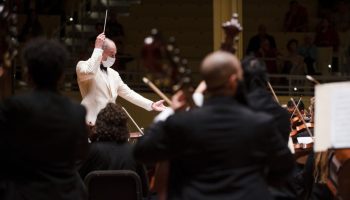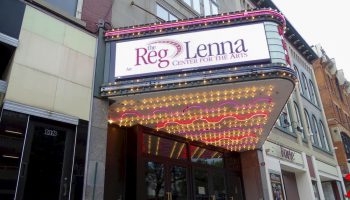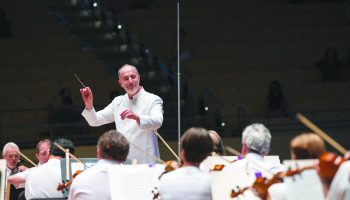Concerto No. 1 in C major, op. 15
Ludwig van Beethoven
One of history’s pivotal composers, Ludwig van Beethoven was born on Dec. 15 or 16, 1770, in Bonn, and died in Vienna on March 26, 1827. He composed five concertos for piano over the course of his career, not counting an earlier rondo movement (WoO 4 composed in 1784), and his transcription for piano of his Concerto for Violin, op. 61. We know that he had plans for yet another concerto for piano that was left unfinished.
A product of his early years in Vienna, his Piano Concerto No. 1, op. 15 was composed in between 1793 and 1795 and was revised in 1800. It actually postdates the Concerto No. 2, op. 19, which was composed in 1788, but considerably revised in 1801 and published after the C major Concerto. op. 15 received its first performance in Vienna on either March 29 or Dec. 18, 1795, at a concert for Beethoven’s benefit with himself as soloist.
The work is dedicated to Anna Luise Barbara (Babette), Princess of Erba-Odescalchi (formerly known as Countess von Keglevich, a pupil of Beethoven and recipient of the dedication of his Piano Sonata, op. 7, among other smaller works). The composer made certain revisions to op. 15 and performed it again at a concert on April 2, 1800. It is scored for flute, two oboes, two clarinets, two bassoons, two horns, two trumpets, timpani and strings.
Beethoven was a great admirer of the music of Mozart, the man with whom he had hoped to study with in Vienna, but who died before Beethoven was able to settle there in 1792. Mozart’s concertos for piano and orchestra made a particularly strong impression on the young Beethoven, who, after hearing a performance of Mozart’s magnificent Concerto in C minor, K. 491, remarked to his colleague, J. B. Cramer, “Ah, Cramer, we will never be able to do anything like that.” It is no coincidence, however, that the earliest notated ideas for Beethoven’s own C minor concerto (No. 3, op. 37) stemmed from that same time. Nevertheless, Beethoven got over his “Mozart complex” and brought new thinking to the genre.
The bold, martial spirit of the first movement (Allegro con brio) may have taken its cue from Mozart’s K. 467 and504—also in the key of C major — but goes beyond those works to explore new key relationships and heavier use of the orchestra. Its memorable opening theme, with its upward leap of an octave and sharp rhythmic profile, (long-short-short-short) sticks in the memory and is exploited ingeniously throughout the movement. The second movement Largo is cast in the remote key of A- flat major, an unusual choice for concertos, symphonies or other multimovement instrumental works whose outer movements were in C major. Its lyricism marked an early attempt of the composer to write soloistic passages for the clarinet. The rondo finale (Allegro) is a rollicking affair, filled with the same kind of swagger and energy that marks the Symphony No. 2, op. 36 that shares this program.
Symphony No. 2 in D major, op. 36
Ludwig van Beethoven
As one of the pivotal figures in the history of Western music, Beethoven’s nine symphonies, five piano concertos, Violin Concerto and several overtures remain at the heart of the symphonic repertory. The Symphony No. 2 is a relatively early work that consolidates his growing mastery of the genre. It received its first performance on April 5, 1803, at Vienna’s Theater an der Wien. This historic venue still exists and is the home for concerts and operas. Beethoven’s Symphony No. 2 is scored for two flutes, two oboes, two clarinets, two bassoons, two horns, two trumpets, timpani and strings.
Three years separate Beethoven’s first and second symphonies. The intervening period witnessed an impressive outpouring of new compositions, including important works such as the Piano Concerto No. 3, op. 37; the ballet Die Geschöpfe des Prometheus, op. 43; seven piano sonatas, opp. 26, 27/1 & 2, 28 and 31/1-3; the String Quintet, op. 29; the Sonatas for Violin and Piano, opp. 23, 24 (“Spring”), and 30/1- 3; the Bagatelles for piano, op. 33; and numerous smaller works for an astonishing variety of media. Clearly, the young Beethoven’s career was now in full sail.
The composer spent the summer of 1802 in the village of Heiligenstadt, which at that time was far removed from the cramped squalor and noise of the city of Vienna. It was here that Beethoven worked on the Sonatas for Violin and Piano, op. 30, a set of Bagatelles for piano, the first two (probably) of the Piano Sonatas, op. 31, as well as putting the finishing touches on the second symphony, which he dedicated to one of his patrons, Prince Karl Lichnowsky.
The issue of Vienna’s noisiness is not irrelevant, as these months also marked the period when Beethoven came to the realization that his hearing, in a state of deterioration since 1796 (so scholars surmise, as the precise setting of the date when his hearing began to fail is impossible to determine), was incurable. Beethoven confided only a few of his friends, notably his physician friend, Dr. Franz Wegeler, and Karl Amenda.
The previous year’s agony was exacerbated by the rejection of Beethoven’s proposal of marriage to the 17-year-old Countess Giulietta Guicciardi. The full force of Beethoven’s crisis is revealed in the famous “Heiligenstadt Testament,” penned in October 1802, in which Beethoven writes to his brothers, (Caspar) Carl and Johann (whose name, perplexingly, is missing from the document). The “Heiligenstadt Testament” has been parsed in various ways, and it is clear that Beethoven’s despondency over his deafness was so deep that he had contemplated taking his own life. I quote the relevant excerpts, translated from Ludwig van Beethoven, ed. Joseph Schmidt-Görg and Hans Schmidt (1970):
“Although born with a fiery and lively temperament and even fond of the distractions of society, I soon had to cut myself off and live in solitude. When, occasionally, I decided to ignore my infirmity, ah, how cruelly I was then driven back by the doubly sad experience of my poor hearing, yet I could not find it in myself to say to people: ‘Speak louder, shout, for I am deaf.’ Ah, how could I possibly have referred to the weakening of a sense which ought to be more perfectly developed in me than in other people?… What humiliation (I felt) when someone, standing beside me, heard a flute from afar off while I heard nothing, or when someone heard a shepherd singing, and again I heard nothing. Such experiences have brought me close to despair, and I came near to ending my own life — only my art held me back, as it seemed to me impossible to leave this world until I have produced everything I feel it has been granted to me to achieve.”
Nothing in the second symphony reveals any of this despair, however. One could, I suppose, read defiance in this work’s audacious virtuosity. Note, for example, the length and complexity of its opening Adagio molto introduction and the lightning speed and brilliance with which the first violins play in the ensuing Allegro con brio. The closest precedent and possible model for this might have been Mozart’s “Prague” symphony, although Haydn’s Symphonies No. 86 and 104 may also have proved influential (all of these predecessors are in D major).
Astute listeners also will not fail to take note of the introduction’s imposing descending D minor arpeggio — a figure that will instantly be recognized by those familiar with the principal theme of the first movement of the ninth symphony. The development section reaches its climax on C-sharp major harmony (functionally the dominant of F-sharp minor). Note how cleverly Beethoven surrounds the C-sharp with pitches needed to lead smoothly back to the home key of D major.
The droll Scherzo: Allegro (no feigned Menuetto this time!) is easily distinguishable by its alternating loud and soft dynamics. The finale, Allegro molto, is an interesting case of Beethoven’s humor, filled with many surprises and false endings. Its opening theme, one of Beethoven’s most sharply chiseled motives, may be seen as kin to the “short-long” figuration (ta-dah) that opens, and may be found throughout, the first movement.
The overall scope of the work led one Leipzig critic writing for the Zeitung für die Elegante Welt to observe that “(the second symphony) is a gross enormity, an immense wounded snake, unwilling to die, but writhing in its last agonies, and (in the finale) bleeding to death.”
While today we might find this review amusing, placed in the context of audiences’ expectations in the early 19th century, it makes a certain kind of sense. One can easily imagine how even more shocking the “Eroica” was to Beethoven’s contemporaries.
Musicologist David B. Levy is professor of music at Wake Forest University in Winston-Salem, North Carolina. He has also taught at the Eastman School of Music of the University of Rochester and the University of North Carolina School of the Arts. A Beethoven scholar, he founded the New Beethoven Research Group and has lectured widely throughout the United States and Europe. Levy will deliver a Pre-Concert Lecture on the program at 6:45 p.m. Saturday, July 21, in Hurlbut Church Sanctuary.





